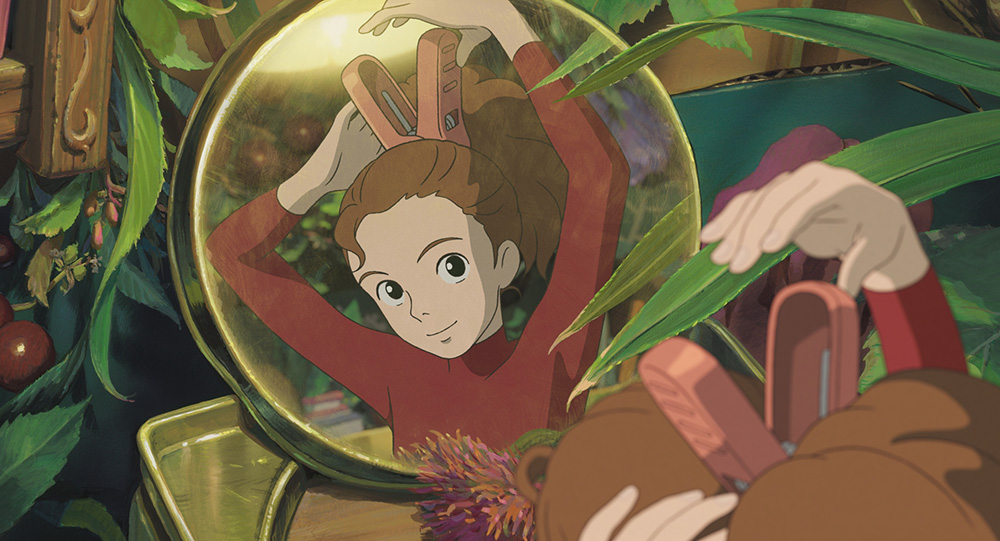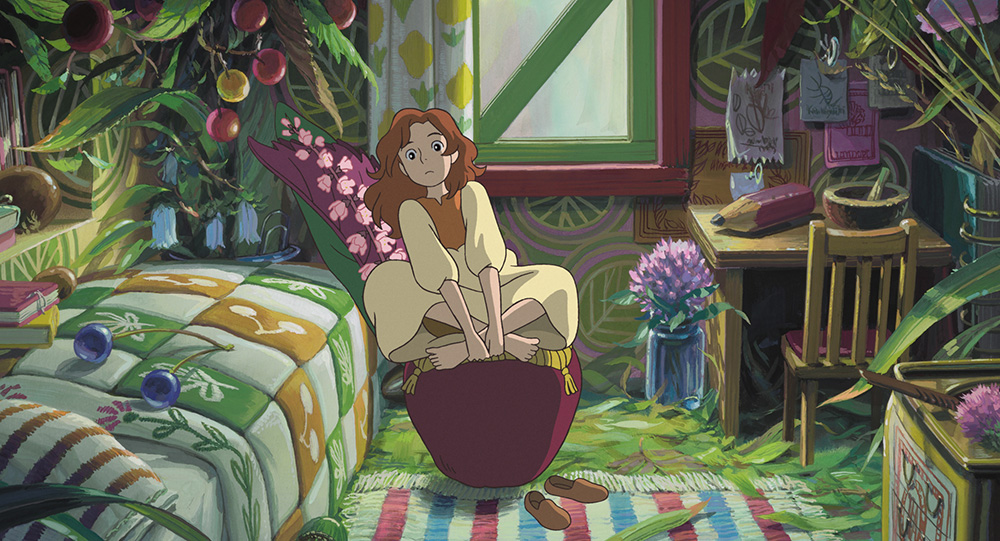Sometimes it’s best not to go looking for danger.
The day has finally arrived for Arrietty (Bridgit Mendler) to become a “borrower.” Just being a four-inch-tall humanoid living in secret under the floorboards and inside the walls of an unsuspecting “human bean’s” house isn’t enough to earn the title. One must embrace bravery and ingenuity to venture out and take that which the family needs to survive without also earning any unwanted attention for what went missing. Would Arrietty love to take a “real’ dresser from the dollhouse upstairs to replace her mother’s (Amy Poehler‘s Homily) repurposed tea cannisters? Of course. But her father (Will Arnett‘s Pod) knows something like that—something hardly used and thus easy to notice in absence—would get the “beans” curious. And nothing is more dangerous to a borrower than curious “beans.”
As the opening to Hiromasa Yonebayashi‘s Kari-gurashi no Arietti [The Secret World of Arrietty] (as adapted by Hayao Miyazaki and Keiko Niwa from Mary Norton‘s novel The Borrowers) proves, Arrietty possesses the characteristics necessary to follow her father’s lead on evening missions to the kitchen for sugar cubes and crackers. It’s a seemingly innocuous scene of arrival for the homeowner’s infirm nephew Shawn (David Henrie) that changes to a heart-pounding suspense thriller as soon as we realize the family cat Niya is hunting the tiny girl as she hides in the yard. Arrietty does well to cover herself in foliage, eluding the feline’s reach and remaining obscured to the “bean.” But the former is keen to her routine and pounces the moment she breaks for the basement grate.
Did Shawn see it? Would he believe his eyes if he did? Were it anyone else unaccustomed to this house and the ancestors who have lived there, the answer would probably be, “No.” But he’s heard the stories. His mother would talk about the “little people” with more intent than mere bedtime lark and we’ll soon discover that his grandfather was so sure of their existence that he had the aforementioned dollhouse built in hopes they might one day reside within its walls. Oh, what a world that would be: “beans” and borrowers living together in harmony. It’s unfortunately nothing more than a fantasy, though, since trust proves a liability. For every kindhearted champion lies ten or more opportunists seeking fame or fortune. Trusting “beans” gets borrowers killed.

Everything changes for Arrietty’s family that night when she and Pod leave their tiny abode to walk along nail bridges and up staple ladders to the kitchen and bedrooms beyond. Sugar procurement is a success, but tissue retrieval hits a snag thanks to the sleepy yet big, open eyes of Shawn gazing upon her. Retreat becomes their only option for survival and the sugar gets lost in the process. And since Shawn calls out for Arrietty by telling her he saw her in the yard that morning, the young girl must admit to her father that their cover has been blown. He agrees not to worry Homily if she promises to be more careful in the future. The problem with curiosity, however, is that it goes both ways.
Arrietty wants to know as much about Shawn as he does about her. They keep their distance, but inevitably learn to cautiously trust the other and escape the otherwise lonely existences their current states provide. Arrietty has never met another borrower with which to befriend—the family isn’t even certain other borrowers still exist. And Shawn’s ailment has kept him on bedrest for so long that his only companions are those people taking care of him. Mom and Dad can’t be bothered anymore thanks to career obligations and his aunt can’t be home twenty-four/seven. So that leaves the housekeeper Hara (Carol Burnett) and Arrietty. What nobody can yet assume is that pursuing the latter for friendship means piquing the former’s interest in finally exposing the myth as truth.
Therein lies the conflict at the center of the film. Hara—a fantastic vocal performance by Burnett in a steady descent towards madness—is desperate to be the one that proves “little people” are real and she’ll do anything to ensure she gets her fifteen minutes. That leaves Arrietty and Shawn as the only ones able to prevent her from getting the borrowers captured or worse. Pod is out searching for an escape route (his people have survived generations knowing to leave the second a “bean” becomes aware of them) and Homily is a worrier prone to fits of fright at the slightest hiccup due to years wondering if her husband’s late arrivals are results of him being eaten by frogs. Shawn and Arrietty accept the challenge.

Like all Studio Ghibli films, The Secret World of Arrietty is an absolute joy to watch for the animation alone. That half of this title takes place in a miniature environment with cutely imaginative uses for everyday items like pen nibs and postage stamps only makes it that much more awe-inspiring and riper for multiple viewings. It absorbs us with its detail and execution, putting us into the struggle that its characters face with believable stakes unfolding in a very quick manner. Because it only takes one glimpse to get the whispers started—one mistake to risk everything in an instant. And both Arrietty and Shawn are rendered with the stubbornness and bleeding heart necessary to get in trouble and subsequently out of it before it’s too late.
Will they find happily ever after? It’s a children’s film, so you can assume they will. Unlike most family fare, however, “happy endings” are allowed melancholic atmospheres and bittersweet goodbyes regardless. And it’s that type of pragmatism and compromise that kids should learn from this kind of art. They need to know that everything won’t work out all the time no matter how much they wish it would. Sometimes you must cut your losses and realize that some things just aren’t meant to be. But that doesn’t mean you shouldn’t be an advocate for change or empathy when others won’t. Caution doesn’t always mean fear. To live is to fight and take chances by trusting your gut. That’s how progress starts. One person’s courage can inspire the world.
photography:
© 2010 Studio Ghibli – NDHDMTW

